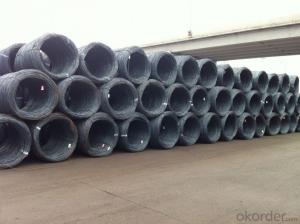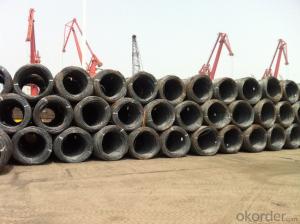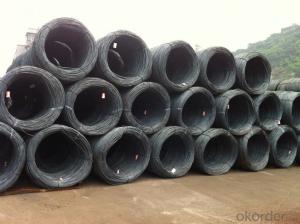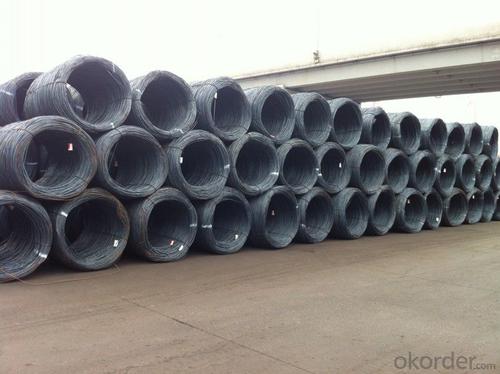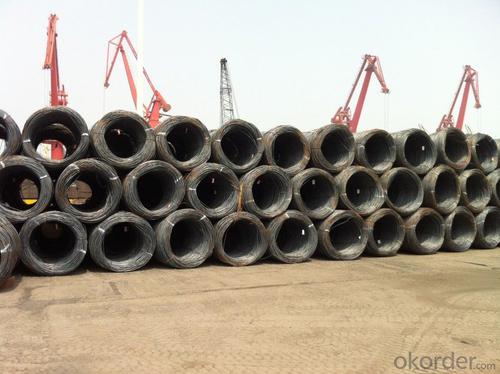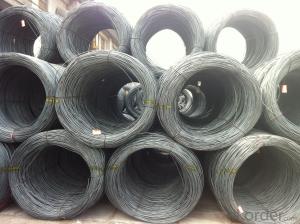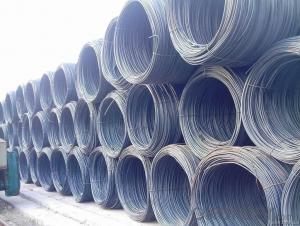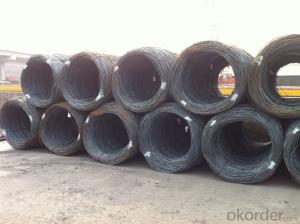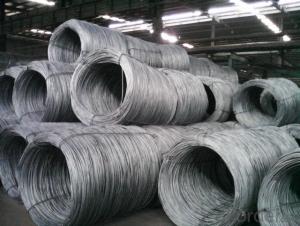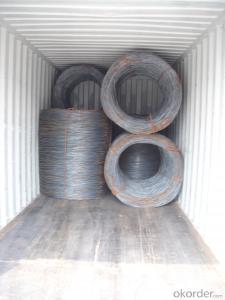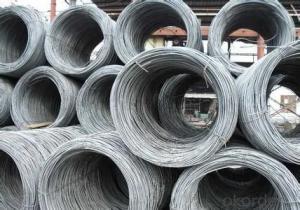Hot Rolled Wire Rods Best Quality and Price
- Loading Port:
- Tianjin
- Payment Terms:
- TT OR LC
- Min Order Qty:
- 25 m.t.
- Supply Capability:
- 20000 m.t./month
OKorder Service Pledge
OKorder Financial Service
You Might Also Like
Specification
Grade: SAE1008 Standard: ASTM
Diameter: 5.5mm, 6.5mm, 7mm, 8mm, 9mm, 10mm, 11mm, 12mm
Alloy or Not: Alloy
Technique: Hot Rolled Place of Origin: China Mainland
Chemical Composition:
Please kindly find our chemistry of our material based on SAE1008 as below for your reference:
Grade | Chemical Composition (%) | |||||
C | Mn | S | P | Si | B | |
SAE1008 | 0.10max | 0.30-0.50 | 0.050max | 0.040max | 0.30max | 0.0008min |
Mechanical properties | ||||||
Yield strength(N/mm2) | Tensile strength(N/mm2) | Elongation (%) | ||||
≥195 | 350-380 | ≥32 | ||||
Usage and Applications of Wire Rod:
After hot-rolled the products shaped into coil and delivery as finished product, including round, square,rectangular, hexagonal and so on. Since most of the products are round, it is generally called wire rod. Carbon steel wire rod is widely used in construction and manufacturing. Carbon steel wire rod is mainly used for reinforcement of reinforced concrete and welded structure or reprocessed (roberts , nail, etc.) materials, especially used to produce wire drawing, welding electrode, nails, spring, electronic, precise machinery parts and so on.
Packaging & Delivery of Wire Rod:
Packaging Detail: products are packed in coil and then shipped by container or bulk vessel
Each coil weight: About 2.05MT
Delivery Detail: within 45 days after received deposit or LC.
Label: to be specified by customer, generally, each bundle has 1-2 labels
Trade terms: FOB, CFR, CIF
FAQ:
Q1: How soon can we receive the product after purchasement?
A1: Within three days of placing an order, we will begin production. The specific shipping date is dependent upon international and government factors, but is typically one month.
Q2: How do you guarantee the quality of our products?
A2: We have established an advanced quality management system which conducts strict quality tests at every step, from raw materials to the final product. At the same time, we provide extensive follow-up service assurances as required.
Q3:What's your payment terms ?
A3:Mostly,we collect the money by T/T and LC at sight . We also accept time LC at 90/120 days sight.
Images of Wire Rod
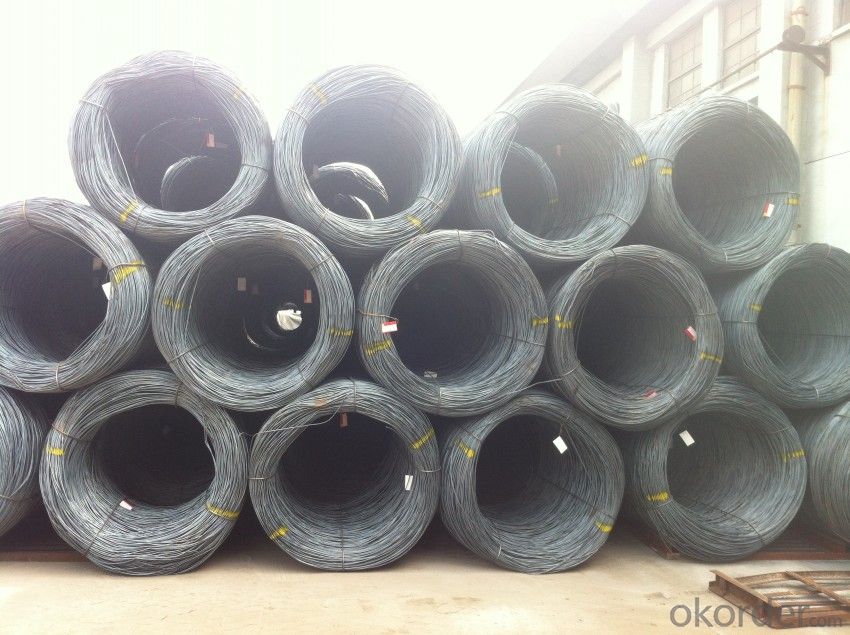
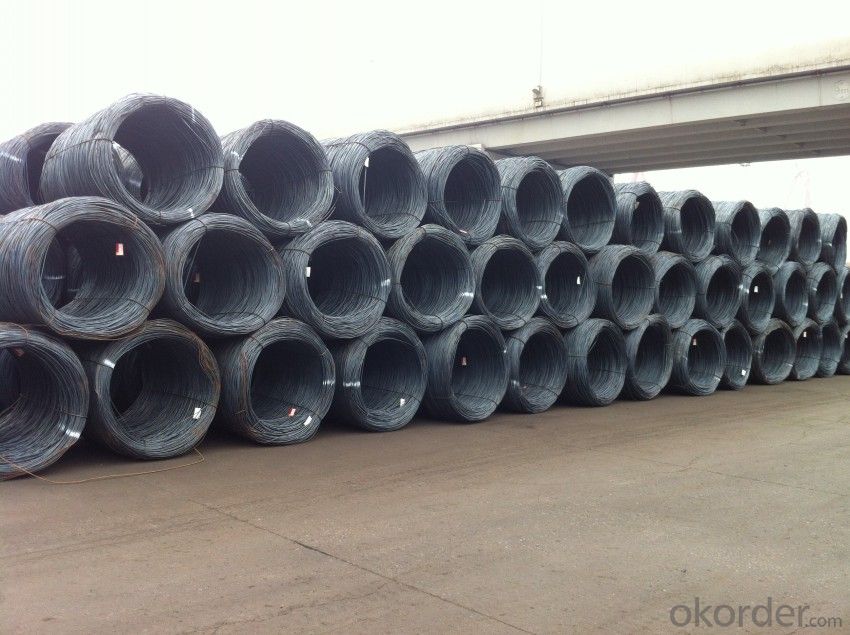
- Q: How is steel wire rod used in the manufacturing of coat hangers?
- Due to its strength and flexibility, steel wire rod plays a vital role in the production of coat hangers. Initially, the steel wire rod undergoes a series of drawing processes to decrease its diameter and increase its tensile strength. This process yields a lengthy, continuous wire that can be easily manipulated and shaped. To construct the frame of the coat hanger, specialized machinery is used to bend and twist the steel wire rod into the desired shape. The wire can be manipulated to form the main body of the hanger, as well as the hook and any additional features like trouser clips or notches for straps. The robustness of the steel wire rod ensures that the coat hanger can bear the weight of heavy garments without bending or breaking. Once the wire frame is formed, it is frequently coated with a protective layer to enhance its appearance and prevent rust. This coating may consist of paint, plastic, or even a thin layer of chrome. Not only does the coating provide an attractive finish, but it also safeguards the steel wire rod from corrosion, extending the lifespan of the coat hanger. In summary, steel wire rod is indispensable in the manufacture of coat hangers due to its capacity to offer the necessary strength, flexibility, and durability required to support various garment types. Its versatility allows for the creation of diverse hanger designs while ensuring they can endure the weight and strain of suspended clothing.
- Q: What are the different types of steel wire rod defects that can occur during wire drawing?
- There are several types of steel wire rod defects that can occur during the wire drawing process. These defects can impact the quality and performance of the final wire product. Some common defects include: 1. Surface cracks: These are visible cracks on the surface of the wire rod and can occur due to improper cooling or excessive rolling pressure. Surface cracks can weaken the wire and lead to premature failure. 2. Internal cracks: Unlike surface cracks, internal cracks are not visible to the naked eye. They can occur due to improper heating or cooling during the manufacturing process. Internal cracks can compromise the wire's strength and ductility. 3. Scale: Scale refers to the oxide layer that forms on the surface of the wire rod during the manufacturing process. Excessive scale can cause surface defects and reduce the wire's corrosion resistance. 4. Decarburization: This defect occurs when the carbon content of the wire rod is reduced due to excessive heating or prolonged exposure to high temperatures. Decarburization can weaken the wire and affect its mechanical properties. 5. Segregation: Segregation refers to the non-uniform distribution of alloying elements within the wire rod. It can lead to inconsistent mechanical properties and affect the wire's performance. 6. Surface defects: These defects include scratches, pits, or indentations on the wire rod's surface. They can occur due to improper handling or inadequate maintenance of the production equipment. 7. Overlaps: Overlaps are defects that occur when the wire rod is not properly aligned during the wire drawing process. This can result in uneven thickness or irregular cross-sections in the final wire product. 8. Surface contamination: Contaminants such as dirt, oil, or rust can adhere to the surface of the wire rod during production or storage. Surface contamination can lead to reduced adhesion, poor surface finish, or corrosion issues. It is important to identify and address these defects during the wire drawing process to ensure the production of high-quality wire products that meet the desired specifications and performance requirements.
- Q: What are the growth prospects for the steel wire rod market?
- The growth prospects for the steel wire rod market are promising, with increasing demand from various industries such as construction, automotive, and manufacturing. The market is driven by infrastructure development, urbanization, and industrialization in emerging economies. Additionally, the rising preference for steel wire rods due to their strength, durability, and cost-effectiveness is expected to further fuel market growth.
- Q: What are the different tensile testing methods for steel wire rod?
- Some common tensile testing methods for steel wire rod include the straightening and tensile testing method, the axial tensile testing method, and the wire drawing tensile testing method.
- Q: What are the main factors affecting the market consolidation of steel wire rod?
- The main factors affecting the market consolidation of steel wire rod are the demand-supply dynamics, industry competition, economies of scale, and regulatory factors. The demand for steel wire rod is influenced by the overall economic growth, infrastructure development, and construction activities. The level of competition within the industry, including the number and size of market players, consolidation trends, and pricing strategies, also plays a significant role in market consolidation. Additionally, the ability to achieve economies of scale through efficient production processes and cost optimization is crucial for market consolidation. Lastly, regulatory factors such as trade policies, tariffs, and environmental regulations can impact the market consolidation of steel wire rod.
- Q: What are the different types of steel wire rod coatings used for electrical conductivity?
- The different types of steel wire rod coatings used for electrical conductivity include copper coating, zinc coating, tin coating, and silver coating.
- Q: What are the major challenges faced by the steel wire rod industry?
- Some major challenges faced by the steel wire rod industry include fluctuating raw material prices, intense competition from alternative materials, such as aluminum and composites, and the need to constantly innovate and adapt to changing market demands. Additionally, the industry often faces regulatory and environmental challenges related to emissions and waste management.
- Q: How is steel wire rod used in the manufacturing of wire forms for suspension bridges?
- The manufacturing of wire forms for suspension bridges relies heavily on steel wire rod. This component is essential in creating strong and durable wire structures capable of withstanding the immense weight and tension exerted on these bridges. One primary use of steel wire rod is in constructing the main cables of the suspension bridge. These cables bear the weight of the bridge deck and traffic load. Typically, the steel wire rod is twisted or bundled together to form a thick cable that can handle the load. The high tensile strength of the steel wire rod ensures that the cables can withstand the forces without stretching or breaking. Aside from the main cables, steel wire rod is also used in creating other wire forms for suspension bridges. These forms include suspenders, hangers, and cross braces. Suspenders are vertical wires that connect the main cables to the bridge deck, providing additional support. Hangers are horizontal wires that connect the bridge deck to the main cables, evenly distributing the load. Cross braces are diagonal wires that offer lateral stability, preventing swaying or twisting. The utilization of steel wire rod in the manufacturing of wire forms for suspension bridges brings numerous advantages. Firstly, steel is renowned for its exceptional strength and durability, making it an ideal material to withstand the high tension and weight requirements of these bridges. Secondly, steel wire rod is highly resistant to corrosion, guaranteeing the bridge's longevity and reducing maintenance costs. In conclusion, steel wire rod plays a critical role in manufacturing wire forms for suspension bridges. Its strength, durability, and resistance to corrosion make it an essential material for creating the main cables, suspenders, hangers, and cross braces that support and stabilize these remarkable structures.
- Q: What are the different types of steel wire rod surface defect identification techniques?
- There are several techniques used for identifying surface defects in steel wire rod. These include visual inspection, magnetic particle inspection, ultrasonic testing, eddy current testing, and dye penetrant inspection. Visual inspection involves visually examining the surface for any irregularities or discontinuities. Magnetic particle inspection uses magnetic fields and iron particles to detect surface cracks and defects. Ultrasonic testing uses high-frequency sound waves to detect internal and surface defects in the wire rod. Eddy current testing uses electromagnetic induction to detect surface cracks and defects. Dye penetrant inspection involves applying a colored dye to the surface, which seeps into any cracks or defects, making them visible under UV light. These techniques help ensure the quality and integrity of steel wire rod products.
- Q: What are the different types of steel wire rod surface defects that can occur during wire drawing?
- Some common types of steel wire rod surface defects that can occur during wire drawing include scratches, pits, scale, cracks, and decarburization.
Send your message to us
Hot Rolled Wire Rods Best Quality and Price
- Loading Port:
- Tianjin
- Payment Terms:
- TT OR LC
- Min Order Qty:
- 25 m.t.
- Supply Capability:
- 20000 m.t./month
OKorder Service Pledge
OKorder Financial Service
Similar products
Hot products
Hot Searches
Related keywords
